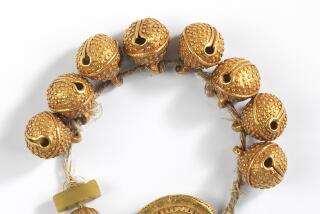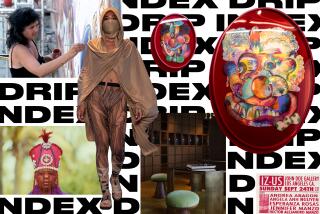Ancient Dispatches From the Holy Land
- Share via
Two parchments of the Dead Sea Scrolls, an ancient inscription believed to be the first mention of the House of David outside of biblical text, the heel bone of a person believed to have been crucified, and a 14,000-year-old sickle handle made of bone--these artifacts, highlights of the Bowers Museum of Cultural Art’s latest exhibition, seem even more precious at a time when travel between the U.S. and the Middle East has become increasingly difficult.
“Arrangements are so complicated, there are so many more layers of security and more strict procedures that we have to follow. It’s not easy to bring things to this country right now,” said Ran Boytner, a research associate with the Cotsen Institute of Archaeology at UCLA and co-curator of the exhibition along with Lynn Swartz Dodd, lecturer-curator with the Archaeological Research Collection at USC’s School of Religion.
Titled “The Holy Land: David Roberts, Dead Sea Scrolls, House of David Inscription,” the show opened Saturday and will be on display in Santa Ana through Jan. 9.
Nearly two dozen artifacts, primarily from the Israel Museum and the Israel Antiquities Authority, have been combined with 66 19th century color lithographs by Scottish artist David Roberts, on loan from the Duke University Museum of Art, and 34 early 20th century photographs from the Ecole Biblique et Archeologique Francaise de Jerusalem.
“We wanted to show how the landscapes evolved in the last 150 years through the lithographs and photographs,” Boytner said. “And through the artifacts, we wanted to actually show the heritage.”
The show is emblematic of the niche the Bowers is trying to carve out among Southern California museums. With only one full-time curator on staff, the Bowers has begun to concentrate on bringing in traveling exhibitions or partnering with other institutions on shows it organizes with guest curators. In 2000, the British Museum’s traveling “Egyptian Treasures” exhibition, for example, and an exhibition from China’s Imperial Palace drew the museum’s largest crowds ever.
“Our mission is to bring diverse cultures together through art and to give people in Southern California an opportunity to see the treasures from the great treasure houses of the world,” Bowers President Peter C. Kellersaid.
The Bowers is exhibiting the House of David Inscription for the first time in the United States. (A replica is owned by the Skirball Cultural Center in Los Angeles, which is presenting a corresponding exhibition exploring the lure of the Holy Land for tourists, pilgrims and scholars over the centuries.)
“The House of David Inscription is the single most important archeological artifact in the state of Israel and is a national treasure,” Boytner said.
Now in the collection of the Israel Museum, the three carved basalt fragments--about 12 inches high and 9 inches wide--were discovered in 1993 and 1994. The Aramaic writing was created about 950 BC as part of a victory stele erected by Hazael, king of Aram, to celebrate the Arameans’ defeat of Israel and Judah. The 13 lines of text make a reference to the House of David, the first and only such reference found outside of the Bible.
“Before the inscription was found, there was the question, ‘Were David and Solomon mythical figures or real people?’ This may very well mean the House of David was not a biblical myth, but a historical fact,” Boytner said.
The parchments of the Dead Sea Scrolls, a cache of manuscripts discovered between 1947 and 1956 in caves on the northwestern shores of the Dead Sea, have been exhibited in the past, but they haven’t been on display in California for 30 years. Believed to be the library of a sect of Jews and dating from the 3rd century BC to AD 1st century, the scrolls include some of the oldest known copies of the Old Testament as well as other records.
Both examples in the Bowers show are on loan from the Israel Antiquities Authority. “The Psalms Scroll From Qumran” contains 41 canonized psalms--seven not found in the Bible. “War of the Sons of Light and the Sons of Darkness” describes an apocalyptic war as the Dead Sea sect saw it.
“We chose these fragments because we wanted one example representing the Old Testament and one representing sectarian writings. The ‘War’ scroll is one of the most famous in the sectarian category,” Boytner said.
Like the inscription and the scrolls, the rest of the exhibition is meant to highlight 15,000 years of human history in the Holy Land. In addition to the 14,000-year-old sickle handle and the heel bone, there are such modern objects as costumes and weapons from the 19th century, and such ancient articles as a Bronze Age female figurine with ties to the pre-Greek Mycenaean culture.
The lithographs and the photographs follow the time line into the 19th and early 20th century. They document village life and create a sense of the landscape. Roberts traveled to the Holy Land in the 1830s, one of the first major Western artists to explore and document the region. The son of a shoemaker, he was born in Stockbridge, Scotland, and first learned his art as an apprentice to a house painter and as a theater set painter. He created the lithographs from drawings and sketches after his return to England. Once they were published--Queen Victoria was one of the subscribers--he was made a member of the Royal Academy.
The lithographs actually formed a starting point for the Bowers exhibition. Boytner and Swartz Dodd then did the research to assemble a three-dimensional component, with Boytner approaching the Israeli museum and cultural officials in 2000 as the peace process there was breaking down.
“Amid dramatically decreasing tourism into Israel, I think the antiquities authority wanted to generate good publicity for the state of Israel,” Boytner said. “They thought it would be great if they could send out some of the best objects from their national collection.”
In part, the objects have traveled so rarely in the past because of their fragility. In fact, the Dead Sea Scrolls can only be displayed for three months a year because light is so damaging to them. For this reason, the exhibition will not travel beyond Santa Ana. There are also security concerns, which were heightened by the terrorist attacks of Sept. 11. Although U.S. and Israeli museum officials would not fully disclose details, transporting the objects overseas was harrowing, Keller said. And the Bowers has increased its security for the exhibition.
The show is worth all the extra effort, Boytner said, because these artifacts have never been shown together.
“Even in Israel, you have to go through different museums to see all the artifacts that are together in this exhibition,” Boytner said. “This area of the world is more relevant today than it’s ever been. This is a region with a very deep and complex cultural heritage.”
*
“THE HOLY LAND: DAVID ROBERTS, DEAD SEA SCROLLS, HOUSE OF DAVID INSCRIPTION,” Bowers Museum of Cultural Art, 2002 N. Main St., Santa Ana. Dates: Tuesdays-Sundays, 10 a.m.-4 p.m. Prices: $7-$12 through Oct. 19; $12-$18 Oct. 20-Jan. 9. Phone: (714) 567-3600.
More to Read
The biggest entertainment stories
Get our big stories about Hollywood, film, television, music, arts, culture and more right in your inbox as soon as they publish.
You may occasionally receive promotional content from the Los Angeles Times.










